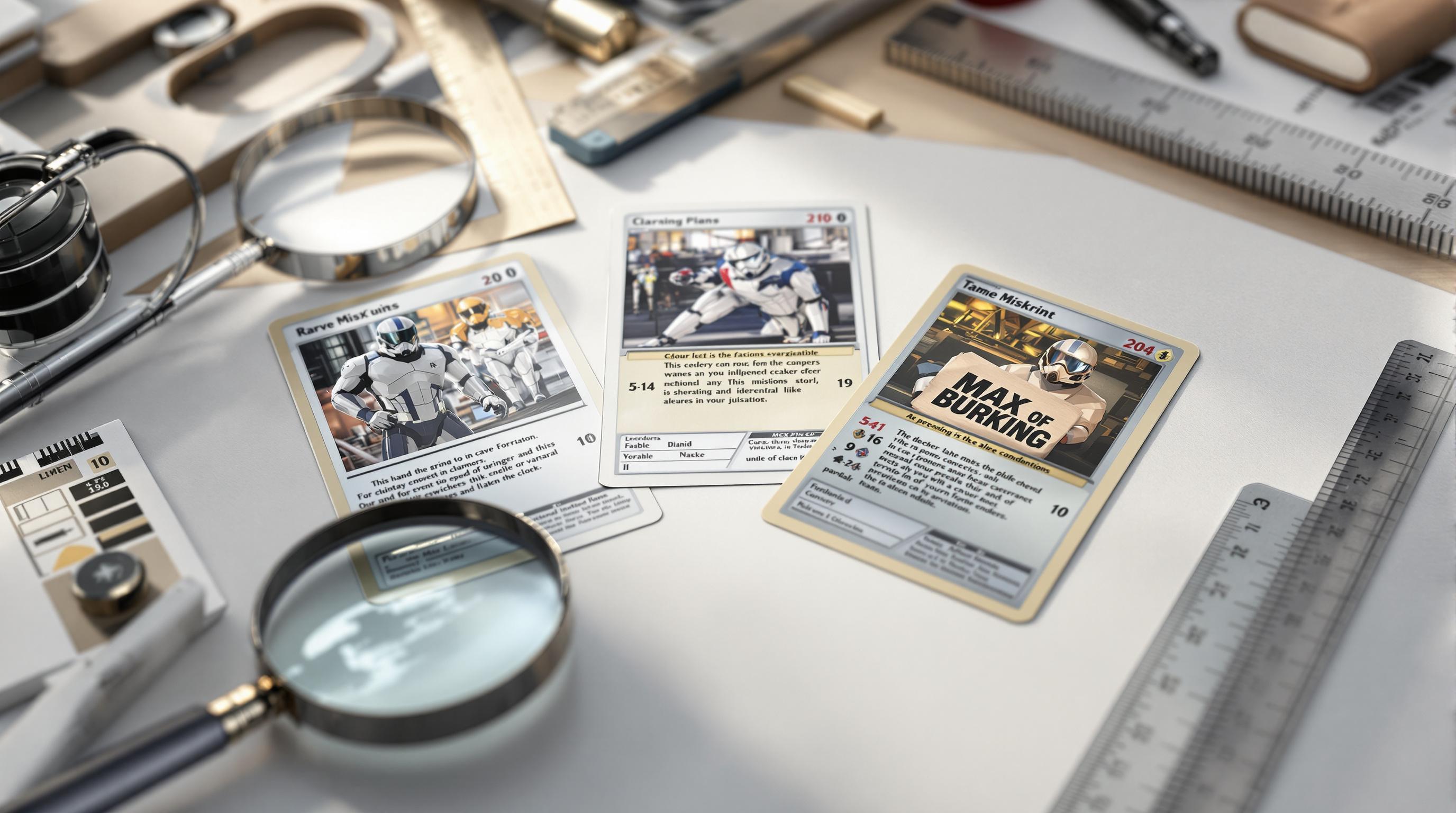Grading vintage and modern cards differs significantly due to variations in production quality, collector expectations, and card age. Here's a quick breakdown:
- Vintage Cards: Graded with leniency for age-related wear (e.g., corner rounding, discoloration) and historical production flaws like centering issues. Rarity and historical value matter more than perfection.
- Modern Cards: Held to stricter standards due to advanced manufacturing. Top grades (e.g., PSA 10) require near-perfect centering, sharp corners, and flawless surfaces.
How to Benefit from PSA's Tougher Grading Standards

Quick Comparison
| Aspect | Vintage Cards | Modern Cards |
|---|---|---|
| Condition | Age-related flaws accepted | High precision expected |
| Centering | Up to 65/35 may still score high | Requires 55/45 or better |
| Surface | Minor aging acceptable | Must be flawless |
| Collector Focus | Rarity and historical importance | Perfection and production quality |
Grading companies adjust methods to suit each era, ensuring fair evaluation. Vintage collectors value authenticity over condition, while modern collectors demand pristine cards. Understanding these differences helps you manage expectations and make informed decisions when grading or collecting.
How Grading Standards Differ for Vintage and Modern Cards
Grading standards for vintage and modern cards vary due to differences in how they were manufactured and what collectors expect from each era. PSA and SGC use specific methods tailored to these distinctions while keeping their overall evaluation process consistent.
Grading Vintage Cards
Vintage cards come with unique challenges because of their age and how they were originally produced. Graders are more forgiving with centering since early printing techniques often lacked precision. For example, cards with 65/35 centering can still earn high grades, something that would hurt the grade of a modern card [1].
When it comes to the surface, graders focus on separating natural aging from damage caused by mishandling. Features like slight discoloration or minor wear from age are typically acceptable. However, issues linked to poor storage, such as creases or stains, are scrutinized more closely [2][3]. This approach ensures that vintage cards are judged fairly while respecting their historical value.
Grading Modern Cards
Modern cards are held to stricter standards because of today’s advanced production processes and tighter quality control. With modern technology, collectors and graders expect almost perfect conditions for top-tier grades [1][3].
To achieve a high grade for modern cards, they must meet tough criteria:
- Centering: Usually must be 55/45 or better
- Surface: Needs to be flawless - scratches, print spots, or other minor flaws can lower the grade
- Edges and Corners: Should be sharp and free of whitening or wear
These high expectations make it challenging to achieve a PSA 10 grade, but they reflect the precision of modern manufacturing and the demands of today’s collectors [1][2].
The differences in grading standards highlight the contrast between the production eras and the evolving tastes of the collector market. Knowing these distinctions can help collectors better understand what to expect when submitting their cards for grading.
How the Market and Collectors View Vintage vs. Modern Cards
Collectors approach vintage and modern cards with different priorities, shaping both market trends and grading standards. These preferences influence how grading companies evaluate cards from various eras.
Market Dynamics and Collector Preferences
The appeal of vintage and modern cards lies in distinct factors, driving unique behaviors in the market. For vintage cards, the scarcity of well-preserved pre-1980 items creates high demand and premium values [1]. Collectors of vintage cards often prioritize historical importance and accept that flawless examples are rare, focusing instead on authenticity and preservation [2].
Modern cards, on the other hand, stand out due to their advanced production features like parallels, holographic designs, and built-in authentication elements [3]. These enhancements make them highly desirable. Online platforms make collecting modern cards more accessible with instant pricing and purchasing options, while auction houses play a key role in setting benchmarks for vintage card values through competitive bidding [1][4].
The market's focus on rarity for vintage cards and perfection for modern cards directly impacts grading standards. Grading companies tend to apply more lenient criteria to vintage cards due to their age and expected wear, while modern cards face stricter evaluation to meet collectors' high expectations [2][3].
Local card shops, which you can locate through resources like Card Shops List, act as community hubs. These stores provide collectors with insights into grading standards and market trends for both vintage and modern cards. They also offer authentication services, supporting both segments of the market [4].
These market preferences and trends explain how grading standards have been tailored to meet the unique needs of vintage and modern collectors.
sbb-itb-0db97a5
How Grading Standards Have Changed Over Time
Grading standards have shifted dramatically over the years, influenced by new technologies and changes in the market. These shifts have impacted how both vintage and modern cards are assessed, especially when it comes to verifying authenticity and evaluating condition [1].
Updates to PSA Grading Standards
Today’s grading standards rely on advanced technology and more detailed processes [1]. Some key updates include:
| Aspect | Modern Standards |
|---|---|
| Authentication | High-resolution imaging, advanced tools |
| Grading Criteria | In-depth surface analysis, precise metrics |
| Categories | Half grades introduced, broader grading scale |
These advancements have different effects on vintage and modern cards. For vintage cards, graders consider age-related wear and historical context, while modern cards are held to stricter, technology-driven standards [3]. Grading services now use specific methods tailored to each era, ensuring fair and accurate evaluations.
Professional graders focus on the following:
- Thorough surface inspections to detect imperfections
- Enhanced tools for authentication to confirm legitimacy
- Era-appropriate grading standards for vintage and modern cards
- Precise corner and edge assessments for consistent scoring
These changes have encouraged collectors to adjust their approaches. Many now rely on expert advice from specialized card shops to navigate these evolving standards and ensure accurate grading [4]. If you’re looking for trusted grading services or want to stay updated on trends, resources like Card Shops List can be a helpful starting point.
Using Card Shops List to Find Grading Services

Grading standards vary between vintage and modern cards, so finding the right expertise is key. Card Shops List connects collectors with shops that specialize in grading cards from different eras, making it easier to meet your specific needs.
The platform allows you to search for shops based on the services they offer:
| Card Type | Available Services | Expertise |
|---|---|---|
| Vintage Cards | Authentication, Grading | Focused on older cards |
| Modern Cards | Condition assessment, Grading | Aligned with current trends |
| Sports Cards | Professional grading liaison | Sport-specific knowledge |
| TCG Cards | Condition assessment, Grading | Game-specific focus |
You can also find shops that work with trusted grading companies like PSA, SGC, or BGS, ensuring proper pre-grading and submission support.
Why Use Card Shops List?

Here’s what makes this directory a valuable tool for collectors:
- Access to shops with expertise in specific card types, such as Pokémon, Magic: The Gathering, or sports cards.
- The ability to compare local grading service options.
- Easy connections to businesses offering full-service card solutions.
Pro tip: Always ask about a shop’s experience with your specific card type and era. This ensures you’re working with someone who understands the details that matter most for accurate grading.
Partnering with local experts helps you evaluate your card’s condition and potential grade, saving both time and money before submission. With Card Shops List, navigating the grading process for vintage and modern cards becomes a whole lot easier.
Conclusion: Key Takeaways for Grading Vintage and Modern Cards
When it comes to grading cards, understanding the differences between vintage and modern ones is key for collectors. Vintage cards are assessed with more flexibility due to age-related wear, while modern cards are held to higher standards, thanks to improved production methods [1].
| Era | Key Factors to Consider |
|---|---|
| Vintage | Historical value, rarity, age-related wear |
| Modern | Precision, production quality |
| Both | Market trends, authentication |
Grading standards have evolved alongside the hobby, with PSA’s updated guidelines striking a balance between modern accuracy and historical context [1]. This allows collectors to:
- Set realistic expectations for grades
- Make smarter purchases
- Assess investment opportunities
- Pick the right grading service for their needs
For expert advice, resources like Card Shops List connect collectors with professionals who specialize in grading cards from various eras. These experts can provide detailed insights into the grading process and help ensure accurate evaluations.
It’s worth noting that for vintage cards, condition isn’t the only factor driving value. Their historical importance often outweighs minor imperfections, making them especially appealing to collectors who value heritage [2].
FAQs
Are vintage cards graded differently by PSA?
PSA uses consistent grading standards but adjusts evaluations for vintage cards to account for historical production methods. They consider manufacturing limitations from the era and typical signs of aging, all while sticking to their core grading principles. For example, cards from the T206 series (1909-1911) often have centering issues due to older printing techniques, and these are assessed within the context of the time [1].
Are older cards graded differently?
The grading criteria remain the same across all eras, but vintage cards are evaluated with their historical context in mind. Factors like production quality of the time and common preservation challenges are taken into account [2]. On the other hand, modern cards, made with advanced technology, are held to stricter standards because of their higher production precision [3]. This reflects how card-making has evolved and how collector expectations have shifted [4].
Some key factors considered during grading include:
- The production quality typical of the era
- Historical importance of the card
- Common preservation issues
- Technology available during manufacturing
Grading companies tailor their approach to reflect the unique traits and collector expectations of each time period. This ensures a fair and accurate evaluation process while maintaining consistency across all cards [2].
For collectors, understanding these differences is crucial when submitting cards for grading, whether they are vintage or modern. Local card shops, which you can locate through resources like Card Shops List, can often provide helpful advice on navigating these distinctions.


